The transient’s key findings are:
- To encourage small companies to undertake retirement plans, policymakers have made it simpler to take part in A number of Employer Plans (MEPs).
- MEPs contain much less administrative burden and fiduciary obligations than a stand-alone plan, and – in principle – could possibly be cheaper.
- However few companies learn about MEPs, some fiduciary duties stay, exiting a MEP could also be troublesome, and MEPs could make mergers and acquisitions more durable.
- Additionally, it’s not clear that they do price much less, and any such evaluation ought to take into account worker – in addition to employer – charges.
- General, whereas MEPs could possibly be enticing, adoption could also be gradual attributable to unfamiliarity with the product and uncertainty over any price benefit.
Introduction
At any given time, solely about half of U.S. personal sector employees are coated by an employer-sponsored retirement plan. Because of this, roughly one-third of households find yourself fully reliant on Social Safety at retirement, whereas others transfer out and in of protection all through their careers and find yourself with solely modest balances in a 401(ok) account.
The shortage of constant protection – a urgent concern for the nation’s retirement earnings safety – is pushed by small employers. Solely about half of small employers (these with fewer than 100 workers) provide a retirement plan in comparison with about 90 p.c of enormous employers. In an effort to decrease the price of plans for small employers and thereby enhance protection, the SECURE Act of 2019 made A number of Employer Plans (MEPs) much less restrictive and doubtlessly extra enticing for this group. This transient, which relies on a latest research, explores each the chances and the restrictions of MEPs in enhancing protection in employer-sponsored retirement plans.
The dialogue proceeds as follows. The primary part gives a quick historical past of MEPs and the creation of a much less restrictive subgroup of MEPs, known as Pooled Employer Plans (PEPs). The second part discusses the potential benefits of PEPs for small employers, and the third part discusses components which will restrict their adoption. The ultimate part concludes that whereas PEPs could possibly be enticing to small companies, employers could also be gradual to undertake them.
A Temporary Historical past of MEPs
Most retirement plans are sponsored and maintained by a single employer. The employer providing the plan is often the named fiduciary and should, based on the Worker Retirement Revenue Safety Act of 1974 (ERISA), “run the plan solely within the curiosity of members and beneficiaries.” Along with serving as a fiduciary, employers have to pick out a recordkeeper, make selections on plan design, file a Type 5500, and canopy the charges concerned in beginning and sustaining a plan. Managing all these duties could also be notably difficult for small employers.
In contrast to single-employer plans, a MEP is a retirement plan adopted by two or extra employers and administered by a MEP sponsor. Though a MEP will be both an outlined profit or outlined contribution plan, the overwhelming majority are 401(ok)-type outlined contribution plans. By permitting employers to hitch collectively to supply a plan, the MEP sponsor (usually a commerce or trade group or skilled employment group) takes on the fiduciary burden and spreads the executive, compliance, and price burden of providing a plan throughout a number of employers. Collaborating employers in a MEP have their fiduciary accountability restricted to choice and oversight of the particular person or entity working their plan.
Whereas MEPs have been round for many years, they haven’t moved the needle on protection. In 2022, MEPs represented solely a sliver – 0.6 p.c – of complete personal sector retirement plans (see Determine 1), overlaying about 6 p.c of energetic members.
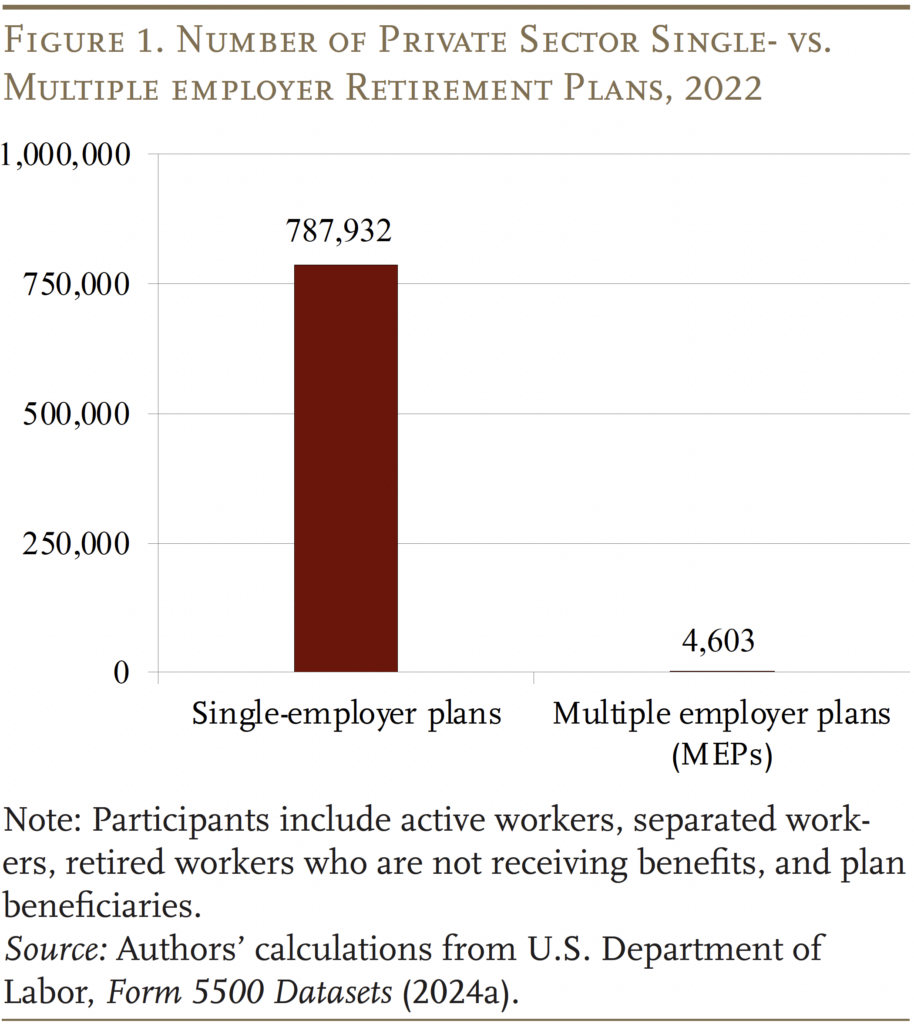
Two essential restrictions of MEPs could have restricted their adoption: 1) employers needed to share a standard bond; and a pair of) the entire MEP may lose its tax-qualified standing if one employer inside the group was not in compliance (the “dangerous apple” rule).
The SECURE Act of 2019 eliminated the “dangerous apple” restriction and created a brand new subclass of MEPs, known as PEPs, which aren’t restricted to employers with a standard bond. The laws mentioned that PEPs can solely be established by a pooled plan supplier (PPP), which takes on the function of named fiduciary and attends to plan administration, compliance, and auditing. PPPs should register with the U.S. Division of Labor (DOL) earlier than publicly advertising and marketing their companies and working a PEP. The extra regulatory necessities are designed to make sure that PEPs function in the very best pursuits of workers.
The elimination of the widespread bond and dangerous apple restrictions has generated plenty of pleasure, notably amongst monetary companies companies, concerning the potential of those new plans to assist shut the protection hole. The newest DOL knowledge, nonetheless, present that preliminary take-up has been gradual, with no vital progress within the variety of MEPs for the reason that passage of the SECURE Act (see Determine 2).
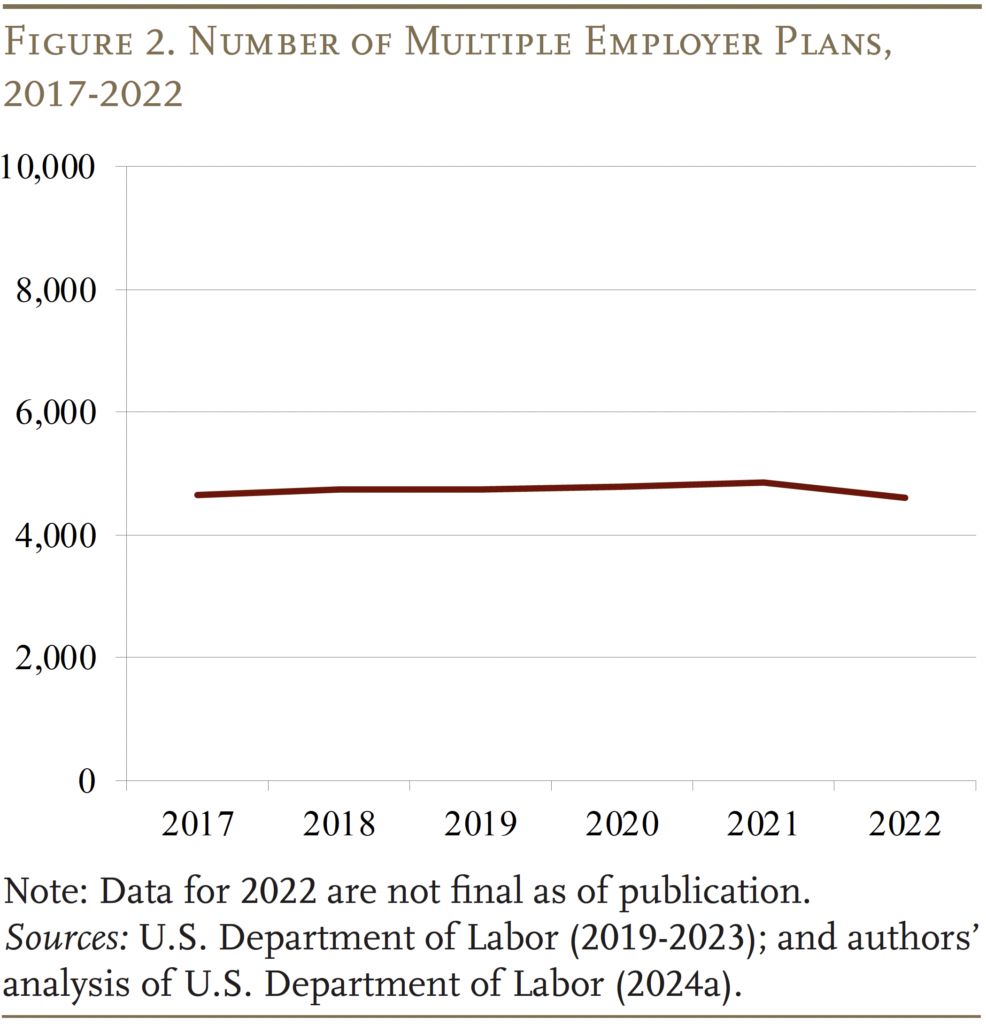
Furthermore, new PPP filings recommend that curiosity in PEPs could also be lower than anticipated. Whereas new filings climbed within the first yr after SECURE was handed, momentum slowed in 2022 and 2023 (see Determine 3). To get a way of the long run for PEPs, it’s helpful to contemplate their benefit relative to present choices for small employers and the way they might fall in need of expectations.
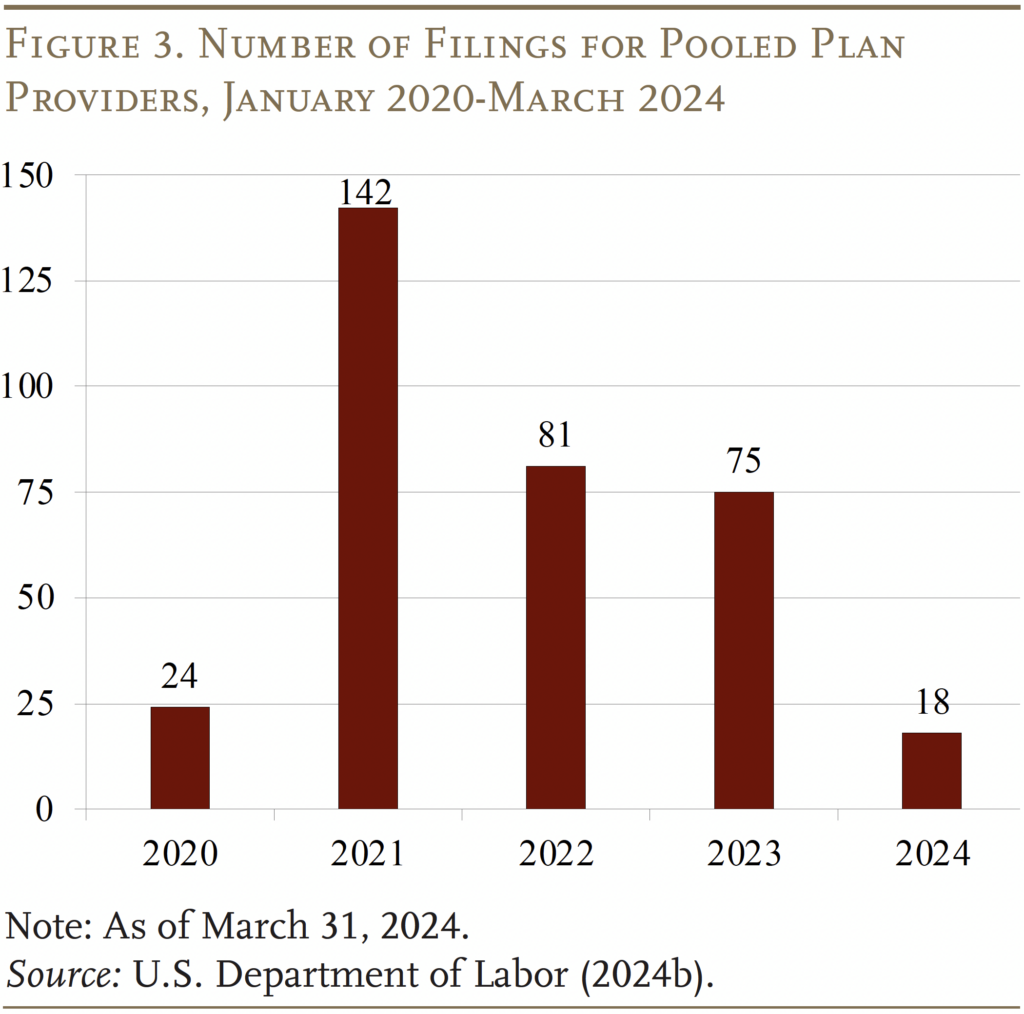
Doable Benefits of PEPs
The promoting factors for MEPs is that they provide benefits over present retirement merchandise for small companies and the potential of decrease prices.
PEPs versus Different Choices
PEPs aren’t the primary retirement plan designed for small companies. Federal policymakers have tried for many years to broaden retirement plan protection amongst small employers. Main initiatives embrace the Simplified Worker Pension IRA (SEP) and the Financial savings Incentive Match Plans for Workers of Small Employers (SIMPLE). And SECURE 2.0 launched the starter 401(ok), an alternative choice aimed toward lowering the prices of providing a retirement plan for small employers. Moreover, 16 states have launched or are getting ready to launch applications requiring employers with out a plan to robotically enroll their workers in an Particular person Retirement Account (“Auto-IRAs”).
Desk 1 compares the traits of PEPs to the provisions of present choices. In contrast to SEP/SIMPLE plans, PEPs don’t require employer contributions, permit the sharing of the mounted prices of creating a plan, and outsource the choice of the fund menu to a PEP administrator. Compared to Starter 401(ok)s, PEPs permit employers to outsource many of the fiduciary and administrative burden, take pleasure in decrease funding charges by aggregating property throughout extra employers, and allow employers to contribute. The principle benefits of PEPs relative to Auto-IRAs is that they’re out there in each state, 401(ok)s have increased annual contribution ranges than IRAs, and employers are allowed to contribute. Briefly, employers may discover PEPs extra enticing than present choices as a result of they restrict fiduciary accountability, whereas sustaining the flexibility to pick out the supplier of selection and provide employer matches. The largest push for PEPs, nonetheless, has centered on prices.
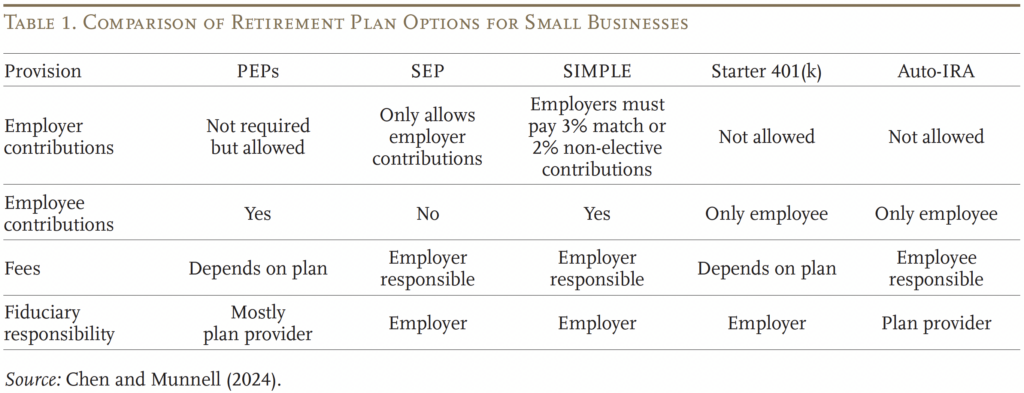
Doable Value Financial savings of PEPs
PEPs promote price financial savings because of the economies of scale related to bringing collectively quite a lot of small employers. Whereas two latest research appear to contradict this rivalry, the outcomes do not likely mirror an apples-to-apples comparability. The research, utilizing MEPs knowledge from earlier than the SECURE Act, discovered that MEPs have been at the least as costly, if no more costly, than single-employer plans of a comparable measurement. That discovering is no surprise, given {that a} MEP with $10 million in property from 100 employers is inherently extra complicated than a single-employer plan with $10 million. The related query is how the common price of a MEP with $10 million from 100 employers compares to the price of a single-employer plan with $100,000. These knowledge aren’t presently out there.
What the information do present is that almost all MEPs are fairly small – about 50 p.c maintain lower than $10 million and about 75 p.c have underneath 100 members. And small plans are costlier than giant ones. One research decided that at the least 30 p.c of MEPs with lower than $10 million in property cost greater than 1.5 p.c for mixed administrative and funding charges.
Going ahead, it could possibly be potential that the expansion in PPPs will promote decrease charges attributable to extra competitors and higher-quality funding merchandise. It may be, nonetheless, that employers with weak bonds to 1 one other pay much less consideration to plan prices. The truth is, one of many two research cited above discovered that, amongst several types of MEPs, complete expense ratios have been increased for Skilled Employment Organizations MEPs, which have weaker employer bonds, than for affiliation MEPs or company MEPs, which have stronger bonds. If the PEP market develops like its mother or father MEPs, it isn’t clear that PEPs will likely be cheaper than single-employer plans – particularly given the expansion in low-cost 401(ok) plan choices for small employers. If PEPs aren’t cheaper, their solely essential profit will likely be much less fiduciary accountability.
One other price consideration is how the charges are cut up between the employer and worker, notably for small plans the place charges are usually increased. Some PEP sponsors promote plans which have minimal charges for employers. Nonetheless, retirement plans aren’t free. Plans which are free (or nearly free) to the employer should invariably cross on prices to plan members. If increased prices are handed on to workers, the query turns into how a lot increased are worker charges relative to single-employer plans? If worker prices are solely barely increased than stand-alone plans, PEPs may nonetheless be useful in serving to employees who would in any other case not have entry to a plan save for retirement. But when prices are considerably increased, PEPs may erode retirement financial savings for probably the most weak employees and expose employers to extreme charge lawsuits.
Elements that May Restrict Adoption of PEPs
Numerous components may restrict the adoption of PEPs. The largest limitation of PEPs stands out as the lack of expertise. The overwhelming majority of small employers has by no means heard of PEPs or their mother or father, MEPs (see Determine 4). PEPs, like all retirement plans, should be “offered” to employers – i.e., employers don’t come on the lookout for them. Suppliers is not going to solely should persuade employers that providing a retirement plan is effective, however that becoming a member of a PEP is the precise possibility for them. This problem is likely to be a excessive hurdle to clear.
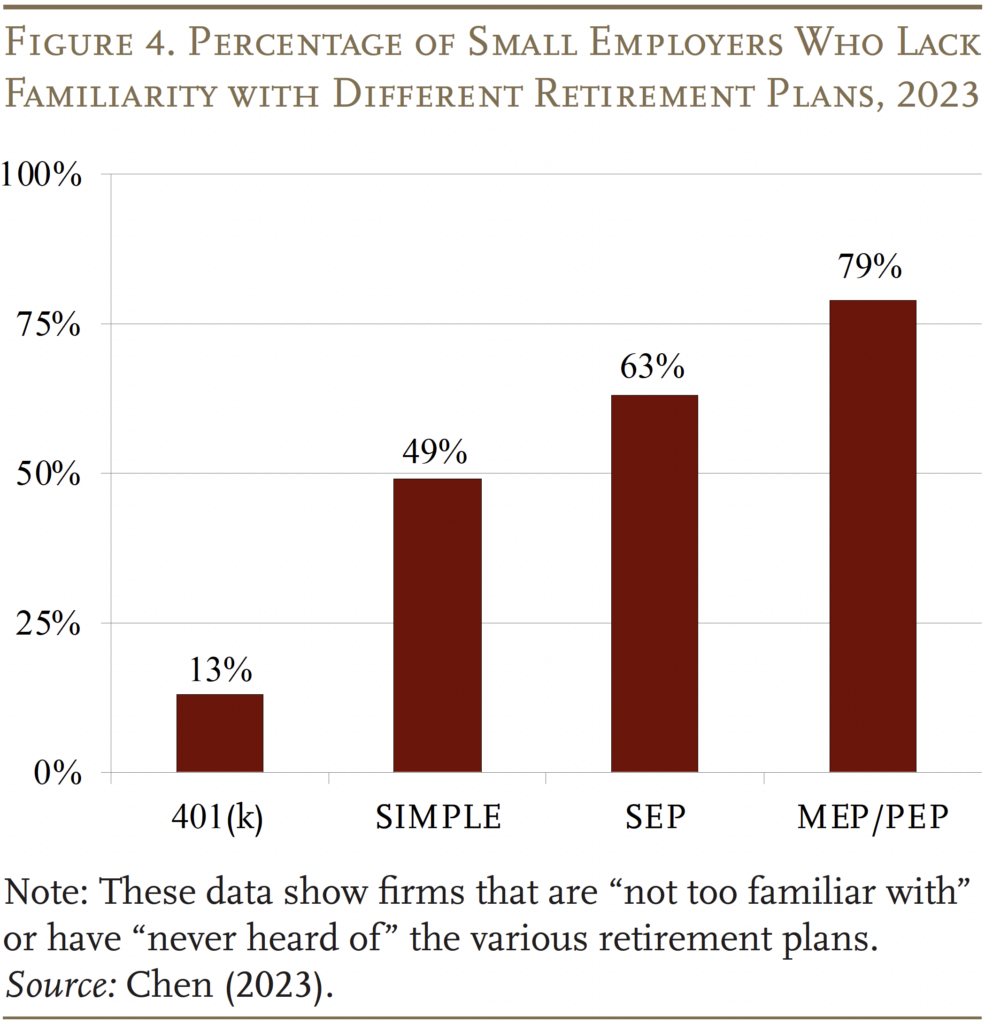
Even when suppliers may overcome the notice hurdle, quite a few points stay.
- Value benefit could not materialize. As famous above, MEPs could prove to not have a price benefit for 2 causes. First, it might be onerous to beat the price of offering a single-employer plan, which has declined dramatically. Second, elevated competitors within the MEPs market may promote decrease charges, however employers with weak bonds may additionally pay much less consideration to plan prices. Lastly, plans which are free (or nearly free) to the employers invariably cross on prices to plan members.
- Employer retains some fiduciary obligations. Whereas the PPP is the named fiduciary for a PEP, the employer is chargeable for choosing the precise supplier, monitoring the charges, and figuring out whether or not the companies provided are useful.
- Exiting could also be troublesome. An employer that will get larger and desires to transform to a extra customizable single-employer 401(ok) could discover it troublesome and time-consuming to terminate its portion of the PEP.
- PEPs also can make mergers and acquisitions more difficult. Whether or not an employer desires to merge its plan with a purchaser’s plan or fold an acquired employer’s plan into its personal plan, the method is way simpler with a single-employer plan.
Clearly widespread adoption of PEPs faces plenty of hurdles; solely time will inform whether or not this much less restrictive model of MEPs makes a dent in protection.
Conclusion
The shortage of constant protection is a urgent concern for the nation’s retirement earnings safety, and the protection hole is pushed by small employers. The unique SECURE Act created PEPs, a subclass of MEPs which are much less restrictive and doubtlessly extra enticing for small employers. Whereas PEPs provide a number of advantages – akin to potential economies of scale and restricted administrative and fiduciary obligations – small employers could also be gradual to hitch PEPs. They’re an unfamiliar product, and it isn’t clear that they are going to have a price benefit over stand-alone plans for small employers.
References
Biggs, Andrew G., Alicia H. Munnell, and Anqi Chen. 2019. “Why Are 401(ok)/IRA Balances Considerably Beneath Potential?” Working Paper 2019-14. Chestnut Hill, MA: Middle for Retirement Analysis at Boston Faculty.
BrightScope and Funding Firm Institute. 2023. The BrightScope/ICI Outlined Contribution Plan Profile: A Shut Have a look at 401(ok) Plans, 2020. San Diego, CA: BrightScope and Washington, DC: Funding Firm Institute.
Chen, Anqi. 2023. “Small Enterprise Retirement Plans: The Significance of Employer Perceptions of Advantages and Prices.” Particular Report. Chestnut Hill, MA: Middle for Retirement Analysis at Boston Faculty.
Chen, Anqi and Alicia H. Munnell. 2024. “A A number of Employer Plans Primer: Exploring Their Potential to Shut the Protection Hole.” Chestnut Hill, MA: Middle for Retirement Analysis at Boston Faculty.
Mitchell, Lia and Aron Szapiro. 2020. “Paperwork or Panacea.” Chicago, IL: Morningstar Coverage Analysis.
Shnitser, Natalya. 2020 “Are Two Employers Higher than One? An Empirical Evaluation of A number of-Employer Retirement Plans.” Journal of Company Legislation 45: 743.
U.S. Division of Labor. 2019-2023. Personal Pension Plan Bulletin. Washington, DC.
U.S. Division of Labor. 2024a. 2022 Type 5500 Datasets. Washington, DC.
U.S. Division of Labor. 2024b. Type PR Registration Filings Search. Washington, DC.

